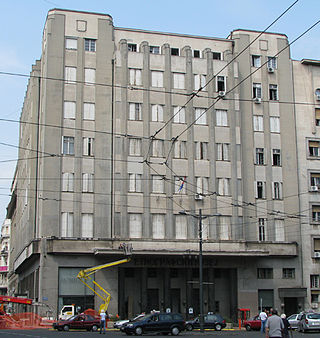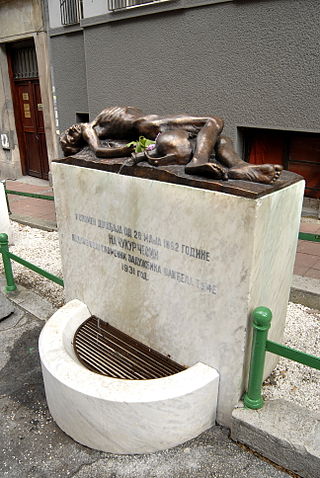Related Research Articles

Knez Mihailova Street is the main pedestrian and shopping zone in Belgrade, and is protected by law as one of the oldest and most valuable landmarks of the city. Named after Mihailo Obrenović III, Prince of Serbia, it features a number of buildings and mansions built during the late 1870s.

The Ethnographic Museum is a museum located in Belgrade, the capital of Serbia. It is one of the oldest museums in the Balkans. The Ethnographic Museum in Belgrade fulfills its mission together with the efforts of various stakeholders in the domain of presentation, revitalization and development of crafts in Serbia.
Baldovin was a Serbian knez (duke) and kaznac that served King Stefan Uroš III. He held the province around Vranje.

The Belgrade printing house was a printing house established by count Radiša Dmitrović in Belgrade, Ottoman Serbia. It was the first printing house in Belgrade. After Dmitrović's death, the printing house was taken over by Trojan Gundulić, who organized publishing of the first and only book of this printing house, the Gospel, printed and edited in 1552 by Hieromonk Mardarije.

The Officers' Club in Belgrade, Serbia is situated at 48 Kralja Milana Street and as the memorial of the development of Belgrade at the end of the 19th century it has the status of a cultural monument.

House of Dimitrije Živadinović is located in Belgrade, in the territory of the city municipality of Stari Grad. It was built in 1904 and represents immovable cultural property as a сultural monument.

The Serbian Journalists' Association Building is in Belgrade, in the territory of the city municipality of Vračar. It was built in 1934, and it represents an immovable cultural property as a cultural monument.

Faculty of Law Building in Belgrade is at 67 Boulevard of Kralj Aleksandar. A work of architectural – urban value, as well as an angular building, built in accordance with the modernist concept, which significantly expands articulates the wider space, as the first building built solely for the purposes of the Faculty of Law, one of the oldest institutions of higher education in Serbia, also has cultural and historical value. The building of the Faculty of Law was declared a cultural monument.

Nikola Spasić Endowment Building in Belgrade, 33, Knez Mihailova Street, was built in 1889 and it is a сultural monument of exceptional importance.

Seismological Institute Building (Serbian: Зграда Сеизмолошког завода, Zgrada Seizmološkog zavoda is located in Tašmajdan, park in Belgrade, the capital of Serbia. Built and adapted from 1908 to 1939, it was the first public building in this part of Belgrade and the first work of architect Momir Korunović, who later projected some of the most beautiful Belgrade buildings during the Interbellum and was nicknamed "Serbian Gaudi". It has been declared a cultural monument in 2007.

The Čukur Fountain incident refers to a series of events in June 1862 in Belgrade, at the time the capital of the Ottoman subject state of Serbia. On 15 June a group of Ottoman nizami (soldiers) and Serbs quarreled by the Čukur Fountain, ending with the murder of a young Serb apprentice boy, which resulted in civil unrest and the bombardment of Belgrade by Ottoman troops. In the wake of the incident, a Great Power brokered conference was held in Constantinople which resulted in a reduction of Turkish citizens and troops on Serbian soil.
Delfa Ivanić was a Serbian painter, humanitarian and together with Slavka Subotić and Nadežda Petrović, one of the founders of the Circle of Serbian Sisters. She was also a translator, writer, editor of magazines and the first Serbian woman to receive Florence Nightingale Medal.

Vladimir Orlić is a Serbian politician who served as president of the National Assembly of Serbia from 2022 to 2024. A member of the Serbian Progressive Party (SNS), he has served in the National Assembly of Serbia since 2014. He has been serving as the vice president of SNS since November 2021. Orlić is known for insulting political opponents and his harsh rhetoric.
Slavica Živković is a politician in Serbia. She has served in the National Assembly of Serbia since 19 July 2018 and in the Assembly of the City of Belgrade since 2012. Živković is a member of the Social Democratic Party of Serbia (SDPS).

Mladen Žujović (1895—1969) was Serbian and Yugoslav attorney and professor of Law at Belgrade University. He was known as member of British-supported secret society Konspiracija and during the World War II as a member of the Central National Committee of the Kingdom of Yugoslavia and since 1943 commander of Yugoslav Army in the Fatherland in Dalmatia, Lika and Western Bosnia and Herzegovina.
Aleksandar Bugarski (1835–1891) was a Serbian architect who combined the new with the old styles giving the city a distinct feature of its own.
Aćim Medović was a physician and writer, the first president of the Serbian Medical Association, secretary of the medical department in the Guardianship of Internal Affairs, a physician of Pozarevac district and professor of forensic medicine at the Velika škola in Belgrade.
Nebojša Atanacković, also known as Boban Atanacković, is an entrepreneur and former politician from Serbia. He was a member of the National Assembly of Serbia from 1993 to 2001, and served as mayor of the Belgrade municipality of Voždovac from 1997 to 2000. For most of his time as an elected official, he was a member of the Serbian Renewal Movement. He has been a prominent member of the Union of Employers of Serbia for many years and is currently its honorary president.
Grigorije Ivanovič Samojlov(Russian Cyrillic: Григорий Иванович Самойлов; Taganrog, Imperial Russia, 8 September 1904 - Belgrade, Serbia, Yugoslavia, 15 October 1989) was a Russian architect, designer and painter who lived and worked in Serbia. He was one of the many academically trained Russian émigrés who after settling in Serbia contributed the architectural landscape of the Kingdom of Serbs, Croats and Slovenes. He built in the spirit of academism, Serbo-Byzantine style, modernism and art deco. He distinguished himself not only with his high skills in designing various types of building, from monumental public buildings to family houses, but also as the author of some of the most beautiful interiors of Belgrade palaces of this period. Also, he painted the likenesses of King Alexander I of Yugoslavia, and scientist Milutin Milanković among the most notable, as well as teaching the art of design and painting.
References
- ↑ "Urban regularisation of Belgrade, 1867: Trace vs. Erasure" (PDF).
- ↑ Blagojević, Mirjana Roter. "Stvaranje Modernog Kulturnog Identiteta Beograda".
- ↑ "Емилијан Јосимовић, наш први архитекта". Политикин забавник. Archived from the original on 2013-01-07. Retrieved 23 January 2018.
- ↑ Šolaja, Vladimir; Magdić, Adela (1994). Course of Serbian engineering in the nineteenth century (in Serbian). Srpska akademija nauka i umetnosti.
- ↑ Barbin, Évelyne; Menghini, Marta; Volkert, Klaus (2019-07-01). Descriptive Geometry, The Spread of a Polytechnic Art: The Legacy of Gaspard Monge. Springer. ISBN 978-3-030-14808-9.
- ↑ Conley, Tanja D. (2020-02-25). Urban Architectures in Interwar Yugoslavia. Routledge. ISBN 978-0-429-68645-0.
- ↑ "Срђ"; Дубровник 1903. године
- ↑ "Београдске општинске новине", Београд 1938. године
- ↑ "Тежак", Београд 1885-1889. године
- ↑ "Емилијан Јосимовић". САНУ. Archived from the original on 4 March 2016. Retrieved 23 March 2018.
- ↑ FNRJ, Akademiski savet (1968). Bulletin Scientifique: Sciences naturelles, techniques et médicales. Section A. Le Conseil.
- ↑ Klusáková, Luďa (2004). "We" & "the Others": Modern European Societies in Search of Identity : Studies in Comparative History. Charles University. ISBN 978-80-246-0786-3.
- ↑ Stammler, Heinrich A.; Stanew, Emilijan (1976). "Nächtliche Lichter". Books Abroad. 50 (4): 909. doi:10.2307/40131189. ISSN 0006-7431. JSTOR 40131189.
- ↑ Vukotić-Lazar, M. M., & Danilović-Hristić, N. M. [2015]. Rast i razvoj Beograda u periodu od 1815. do 1910. godine. Zbornik radova Filozofskog fakulteta u Prištini, (45—3), 51-80.Српски цитатни индекс Приступљено 28 January 2018.
- ↑ "Калемегдан". Дан у Београду. August 2015. Retrieved 28 January 2018.
- ↑ Стојановић, Дубравка (2017). Калдрма и асфалт: урбанизација и европеизација Београда 1890-1914 (четврто ed.). Београд: Удружење за друштвену историју. p. 140.
- ↑ Објаснење предлога за регулисање онога дела вароши Београда што лежи у шанцу : са једним литографисаним планом у размери 1/3000 / од Е. Јосимовића. - [Београд] : у Државној књигопечатњи, 1867. - [4], 47 стр., [1] савијен лист. COBISS 135618823
- ↑ Објаснење предлога за регулисање онога дела вароши Београда, што лежи у Шанцу : са једним литографисаним планом у размери 1/3000 / Е[милијан] Јосимовић. - Београд : Друштво урбаниста Београда, 1997. - 45 стр. : планови; 23 cm. / Фототипско изд. издања Државне књигопечатње из 1867. COBISS 16129039
- ↑ Deane, Darren; Butler, Sarah (2016-12-05). Nationalism and Architecture. Routledge. ISBN 978-1-351-91579-3.
- ↑ "Emilijana Joksimovica, Belgrade, Serbia, Street View, Geographic.org". geographic.org. Retrieved 2020-06-16.